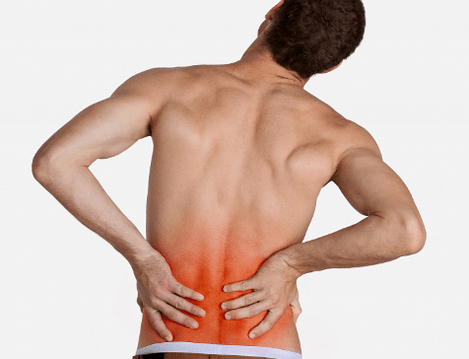Lumbar osteochondrosis is a spinal deformation in the lumbar region.The disease affects the intervertebral disc, cartilage tissue, spinal root and nerve fiber and causes back pain.
Cause

The main cause of the disease is the unnatural distribution of loads in the musculoskeletal system.This usually happens when walking on high heels, wearing bags on one side, with uncomfortable pose in a dream or in a seat.At risk are parents, pregnant, only born, professional athletes and office workers.
Other causes of lumbar osteochondrosis:
- injury, bruises, arms, legs, spine;
- damage to the organ of the musculoskeletal system;
- gastrointestinal disease that triggers deficiency of beneficial substances;
- body tension at prolonged load;
- Psychoemotional disorders;
- violation of blood flow in the spinal column;
- inflammation of the musculoskeletal device;
- internal organs and vertebrae infections;
- joint stiffness, disc displacement;
- highlights and intervertebral hernia;
- severe intoxication;
- metabolic disorders;
- posture curvature;
- SEDENTARI LIFE;
- dehydration;
- Unbalanced diet;
- Calcium deficiency and oxygen;
- Overweight;
- bad habits;
- Age -related changes;
- A common disease.
Symptoms of lumbar osteochondrosis
The intensity and nature of the symptoms depend on the level of the disease.The sooner the patient found the signs of lumbosacral osteochondrosis, the more effective treatment will become.
General symptoms:
- severe pain in the lower back, which can give the feet, the internal organs of the stomach and pelvis;
- kidney and sacrum pain;
- fatigue and pressure in the lower and sacred part of the spine;
- difficulty moving, walking, tendency and circumference of the body;
- Periodic background in the back;
- fatigue after small loads;
- Crunch in the back, mobility violations, pain in quiet conditions;
- numbness of limbs;
- cramps and cramps in the muscles;
- dizzy;
- weakness and loss of strength;
- Reduces muscle tone and sensitivity.
In men and women, manifestations of lumbar osteochondrosis may vary.Men may have problems with potential.Women often experience pain in the pelvis.When a defective spine cannot fully support the back, the uterus and complement suffer an additional burden, and sometimes move on the normal physiological position.
Variety
Lumbar spinal osteochondrosis classification is made up of several types of diseases.With the type of pain syndrome, they distinguish:
Lumbago.Acute symptoms.It is expressed by sharp bastards and inability to move.It occurs with muscle cramps, injuries, disc fluids and nerve roots.
Lumbalgia.It is characterized by long -term pain caused by hernia, protrusions, spondylarthrosses, ligaments and other disorders of the musculoskeletal system.
Sciatica.Strong pain syndrome in the lumbosacral department, Eradiri in the basin.Pain occurs for the sciatic nerves, prevents bending and normal body extensions, preventing me from sitting and standing without pain.
Discogenic lumbar osteochondrosis and radiculopathy are also distinguished.
Discogenic lumbar osteochondrosisIt is accompanied by loss of sensitivity and numbness not only back pain, but also the feet, buttocks, hips and lower abdomen.Sometimes body temperature increases, weakness, urinary incontinence, weight loss patients.
RadiculopathyExpressed by the numbness of the nerve roots and decreased the ability of the human motor.Signs - pain or lower body pain, impaired reflex, decreased muscle tone and limb joints.
Stage of development of lumbar osteochondrosis
Doctors detect pathological dynamics in four stages:
- First.Symptoms are almost invisible - they are diagnosed in X -ray.The level begins with the pathological process in the cavity of the disc and the microcess of fibrous rings.
- The second.The height of the intervertebral disc is reduced, making the vertebra close.This causes sliding and displacement of the vertebra, which is accompanied by pain during movement.
- The third.It is characterized by stiffness, instability, body numbness in coccyx, lower back and sacrum.This can be explained by prominent vertebrae, ownership, joint dislocation and arthrosis in the spine.
- Fourth.The worst degree.The function of the spinal column is affected and bone growth (osteophytes) is formed.Growals can pinch the nerves or damage the integrity of the vertebra.
As a result of lumbar osteochondrosis
- Excessive accumulation of salt in the body;
- hernia development, highlights, vertebral prolapse and disc;
- chronic radiculitis;
- Paresis and paralysis.
Diagnostics
Lumbar osteochondrosis and other disorders of the musculoskeletal system can diagnose orthopedists, osteopaths, neurologists, rheumatologists, manual therapists and surgeons.It is possible to make the right diagnosis after:
- X -ray spinal column, which indicates bone, cartilage and muscle tissue, as well as ligaments and tendons.
- Myelography - a cerebrospinal fluid study with dye.With its help, the spinal cord nerve root is studied and evaluated.
For more detailed examinations, doctors use CT and MRI.You can undergo diagnostics at the clinic.

























